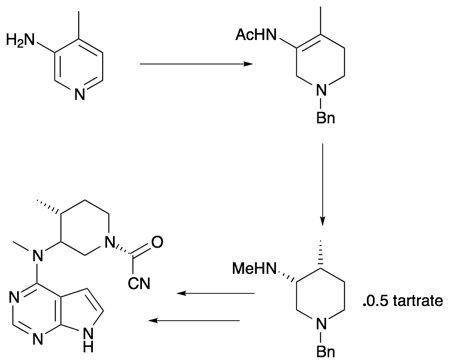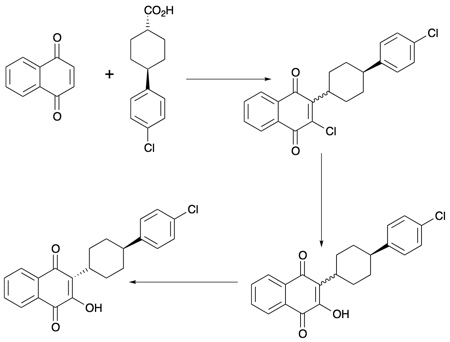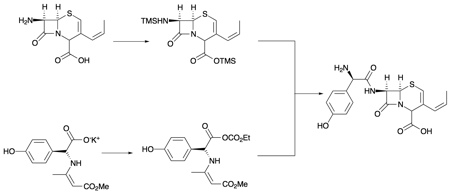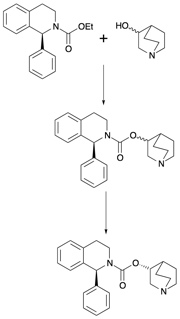Just because a drug has made it to the market does not mean there is no room for improvement in its synthesis. If the originator company is to alter its process, then there are the additional costs involved of changing the approved manufacturing process with the regulator, but if the savings are substantial then this can be well worth doing. Generics companies are not constrained in this way, and if they are to bring out their own versions on patent expiry, finding the cheapest possible way to make it will be advantageous to their bottom line in this very margin-driven sector of the market.
One example is the manufacturing process developed by Indian company Unichem to make tofacitinib, the small molecule rheumatoid arthritis treatment developed by Pfizer, and marketed as Xeljanz.1 The company focused on the synthesis of the key intermediate (3R,4R)-(1-benzyl-4-methlypiperidin-3-yl)methylamine, and its subsequent conversion to the citrate salt of the API. The authors state that the manufacture of this intermediate is the most costly part of the process, as it is both tedious and requires an expensive reagent, and while alternative syntheses have been published, these have numerous drawbacks, including complexity and poor chiral purity.

Tofacitinib
In their new synthesis of this intermediate, the starting point was 3-amino-4-methylpyridine, which is both commercially available and cheap. By treating this sequentially with acetyl chloride, then benzyl chloride, and finally sodium borohydride, without isolating the intermediates, the required benzyl acyl intermediate was formed. This was then treated sequentially with hydrochloric acid, titanium(IV) tetraisopropixide, methylamine and sodium borohydride, and finally di-p-toluoyl-L-tartaric acid, again without intermediate isolation, giving the required key intermediate for tofacitinib as its tartrate salt. The overall yield was 26%, compared with the overall yield of 15% for a previously reported process. Importantly, its ee was 97%, a significant improvement on the 68% ee reported for a comparable intermediate, with no requirement for expensive metal catalysts.
A significant improvement in yield comes in the shape of a new synthesis of the antimalarial prophylactic drug atovaquone from chemists at another Indian company, Ipca Laboratories.2 It is typically found in combination with proguanil hydrochloride, marketed by GlaxoSmithKline as Malarone, but its prohibitive cost makes its use as a first-line malaria treatment in developing countries unrealistic – it is even more expensive than the artemisinin drugs. Therefore, a more efficient synthesis is needed if it is to become more widely available.
The first reported synthesis of the molecule had an overall yield of just 4%, and while more recently published processes have increased yields 10-fold, they are impractical variously because of cost, lack of starting material availability, and a requirement for expensive reagents and catalysts.

Atovaquone
The Ipca team started by repeating that 4% process to see why the yields were so poor, and found that the key free radical mediated coupling reaction of 2-chloronaphthoquinone and trans-4-chlorophenylcyclohexane generated four isomers – the two stereoisomers of the desired coupling product plus the two stereoisomers of its counterpart with no chlorine on the quinone ring. They struggled to reduce the amount of dechlorinated product produced, and instead looked at whether atovaquone could be synthesised from this intermediate instead.
First, they established that the initial coupling reaction worked just as successfully with the dechlorinated naphthoquinone, giving a 1:2 ratio of desired to undesired isomer. The correct isomer was transformed into atovaquone via chlorination and subsequent dehydrochlorination of the quinone double bond, followed by a basic hydrolysis. This strategy also worked with the ‘wrong’ isomer, and they decided that isomerisation at the final step was the way ahead. This was achieved using 90% sulfuric acid at room temperature. Ultimately, the two isomers can be carried through the process unseparated, and following that acid-mediated isomerisation, an overall yield of 42% of atorvaquone was achieved – an order of magnitude better than the original synthesis, and without the use of expensive reagents relied upon in previous alternative routes.
The published synthesis for abiraterone acetate (Zytiga, Janssen), a cornerstone of treatment for metastatic, castration-resistant prostate cancer, involves a palladium-mediated Suzuki coupling, and the route requires costly triflic anhydride and column chromatography. Yields are reduced if these are avoided by the crystallisation of the product as its mesylate salt instead. An alternative protocol developed by chemists at Ranbaxy in India avoids chromatography and multiple recrystallisations, gives an improved yield, and can be used on a large scale.3
The original starting material for the Suzuki coupling was an iodoandrostadienol, but the Ranbaxy team found that simply replacing the iodo substituent with bromine cut the reaction time from days to hours; synthesising this intermediate is also cheaper as it uses N-bromosuccinimide rather than the iodine analogue, which costs nearly 20 times as much. An additional advantage was the reduction in the production of a Heck side-product on account of the faster reaction. Switching the solvent from THF to t-butanol also shortened the time taken, and gave better conversion. Several palladium catalyst alternatives were also tried, with Pd(PPh3)4 and Pd(PPh3)2Cl2 both giving good results; the former was chosen as it is cheaper, more readily commercially available, and it gave a shorter reaction time.

Abiraterone
Finally, they addressed the work-up. The crude filtered product contained residual pyridyl starting material, and multiple recrystallisations were required to remove it, with the inevitable loss of product. Instead, an acid–base purification procedure was applied, with the crude, wet solid suspended in methanol and water, acidified with concentrated hydrochloric acid, and the impurity extracted with hexane. The pH of the aqueous layer was increased using aqueous sodium hydroxide, resulting in the desired coupling product being isolated with a purity in excess of 99.5%. This was made into the final acetate product using acetic anhydride plus catalytic DMAP.
Another group of chemists from Ranbaxy has developed an improved synthetic route to cephalosporin antibiotic cefprozil, a broad spectrum antibiotic invented by Bristol-Myers Squibb that is used to treat a variety of infections, including those of the skin, ear and respiratory tract.4 It is produced commercially via the condensation of an acid chloride of p-hydroxyphenylglycine or the mixed anhydride of Dane salt with the beta-lactam intermediate 7-amino-3-(propen-1-yl)-3-cephem-4-carboxylic acid, or 7APCA. The Dane salt route is preferable as it is commercially available and gives a better yield, and the acid chloride is somewhat unstable.
ICH guidelines demand that process impurities must be controlled in an API at a level no greater than 0.15%, but this condensation reaction gives between 0.3% and 0.8% of the side product ethylcarbonylcefprozil, which is well above the permitted level. It could not be removed by purification, and thus it was important to find some way of controlling its formation during the synthesis. They believed it was being formed via the reaction of the phenolic hydroxyl group on the hydroxyphenylglycine with ethyl chloroformate during the step to make the mixed anhydride of Dane salt.
Their investigations showed that if a catalytic amount of an organic acid, plus a catalytic amount of N-methylmorpholine, were added then this greatly reduced the amount of impurity formed. Various different organic acids were assessed, and the best results achieved with methanesulfonic acid. When this material was carried through to the synthesis of cefprozil, the level of the impurity was between 0.04% and 0.07%, well below the permitted level.

Cefprozil
An improved route to the hepatitis C antiviral drug boceprevir (Victrelis, Merck), developed by chemists at Dr. Reddy’s Laboratories in India, avoids the use of phosgene and isocyanate, both of which are very toxic, unstable and present significant handling challenges.5 In their synthesis, the initial coupling step is mediated via the water-soluble carbodiimide EDC•HCl, which gave better yield and purity than alternatives such as CDI, TBTU, DCC and BOP, and also a faster reaction. The big advantage here is that the main by-product is water-soluble, facilitating a simpler purification process that delivers a 90% yield and purity above 99%.
The methyl ester is then converted to an acid using sodium hydroxide, ready for a second coupling reaction which, again, was achieved via EDC•HCl mediation, this time with the addition of a small amount of HOBt in addition to N-methyl morpholine. Without the HOBt, the levels of impurities increased, and the starting material was not fully converted. Multiple reagents were screened for the next step, an oxidation to form. Those discarded included TEMPO, as 1 equivalent of the genotoxic reagent was required, DMSO because the odour of dimethyl sulfide was unavoidable on a large scale, and potassium permanganate plus oxone did not go to completion.
Ultimately, success was achieved using Dess-Martin periodinane in ethyl acetate. Even here, an acceptable yield and purity was challenging as the last half-per cent or so of starting material was not converted, and when more than 1.6 equivalents of reagent or longer reaction times were employed, an α,β-unsaturated carbonyl by-product was formed by elimination as a major impurity. They could not generate sufficiently pure material via solvent extraction or crystallisation techniques; ultimately, a sodium bisulfite adduct formation provided the answer, giving boceprevir in a purity above 99.4%. Ultimately, they managed to telescope several steps to avoid the isolation of intermediates, which raised the overall yield to 35% from 23% for the stepwise process including intermediate isolation.

Solifenacin
Solifenacin succinate is an antimuscarinic drug used to treat overactive bladder, developed by Astellas and sold under the brand name Vesicare. It contains two chiral centres and thus exists in four diastereomeric forms. There are two common syntheses: one involves a transesterification between two chirally pure starting materials; in the second, the transesterification is between one racemic partner, a tetrahydroisoquinoline, and a chirally pure quinuclidinol, followed by a resolution to separate the two diastereomers that were formed on coupling. While using one racemic and one chirally pure starting material is cheaper than two enantiopure ones, the separation is somewhat involved and very inefficient, giving just 10% of the required form of the molecule.
An alternative method using the cheaper racemic starting material has been developed by chemists from Aurobindo Pharma.6 They chose to make a chirally pure isoquinoline, and couple it to a racemic quinuclidinol, which is significantly cheaper than the enantiopure ingredient used in the earlier syntheses. The transesterification reaction was achieved using sodium hydride at reflux in toluene, producing a 1:1 mixture of diastereomers, as might be expected. The ethanol formed as a by-product was removed via azeotropic distillation with toluene.
On cooling and after a water quenching, the product mixture was given an acid-base workup before being extracted in ethyl acetate, dehydrated, and used without further purification to produce the necessary succinate salt via reaction with succinic acid.
They then turned their attention to the resolution. As only two of the possible diastereomers were formed, crystallisation using succinic acid as the resolving agent was possible. Experiments to determine the best solvent led to a mixture of ethyl acetate (the solvent used to extract the diastereomers in the first place) and ethanol as the optimal choice. The result was solifenacin succinate that meets ICH purity requirements in high yield, but from cheaper starting materials.
The antiepileptic drug eslicarbazepine acetate (Aptiom, Sumitomo) is a pro-drug of an active metabolite of oxcarbazepine, another antiepileptic. Numerous syntheses are available, both chemical and enzymatic, with those relying on resolution to generate the desired single enantiomer generally being two-step processes that give only modest yields. While asymmetric transfer hydrogenation gives much better yields, it uses expensive ligands and catalysts, and sensitivity to air is also an issue.

Eslicarbazepine
Chemists at Codexis have come up with an alternative synthesis involving biocatalysis.7 Rather than the enzyme being used for resolution, as in previous synthetic routes, they created one that was capable of catalysing the synthesis of the chirally pure form of the molecule in the first place.
They used the company’s expertise in the directed evolution of enzymes to generate a ketoreductase enzyme that was specifically evolved to manufacture eslicarbazepine in an efficient manner. The starting point was to screen a panel of ketoreductases, and they identified several that had high enantioselectivity for the reduction of oxcarbazepine to eslicarbazepine. However, these all had substrate loadings of around 2g/l, which is too low for an efficient manufacturing process. The yield was far from good enough, either.
Directed evolution was employed to create libraries of ketoreductase variants for screening, and about 15,000 variants were screened for activity across four rounds of evolution, all with an eye on the desired final process conditions – low co-factor loading to keep costs down, high concentrations of the cofactor reductant isopropanol to drive equilibrium and maximise solubility, and that functioned at high temperature to speed up the reaction.
Once promising enzymes were identified, they were produced at multi-gram scale and isolated as a powder via freeze drying for testing to determine the optimal process conditions, including temperature, isopropanol concentration, pH and substrate loading in a design of experiments study. The optimised conditions and engineered enzyme have been used to synthesise eslicarbazepine in high purity and yield, and similar results have been seen at a process scale as were observed in the laboratory. The enzyme is now being assessed for the commercial production of the drug.
References
1. Y.S. Patil et al. Org. Proc. Res. Dev. 2014, published online ahead of print, DOI: 10.1021/op500274j
2. S.Y. Dike et al. Org. Proc. Res. Dev. 2014, 18, 618
3. M.K. Madhra et al. Org. Proc. Res. Dev. 2014, 18, 555
4. B.P Rai et al. Org. Proc. Res. Dev. 2014, 18, 662
5. D.S. Bhalerao et al. Org. Proc. Res. Dev. 2014, published online ahead of print, DOI: 10.1021/op500065t
6. G.N. Trinadhachari et al. Org. Proc. Res. Dev. 2014, 18, 934
7. N.K. Modukuru et al. Org. Proc. Res. Dev. 2014, 18, 810
